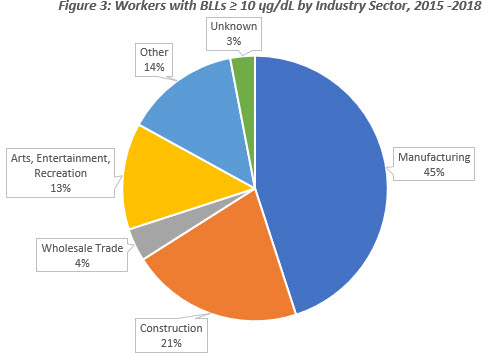For Public Health Professionals
Lead poisoning continues to be a significant problem in the U.S. and elsewhere. While lead poisoning does occur in adults outside the workplace, most adults are exposed to lead on the job. Even though blood lead levels (BLLs) have gone down in the general population, thousands of people in the U.S. still work under conditions that can cause BLLs high enough to harm their health.
The Occupational Lead Poisoning Prevention Program (OLPPP) provides services to prevent and reduce lead poisoning among California workers, including conducting surveillance and case investigation. OLPPP tracks BLLs of workers through the California Occupational Blood Lead Registry (Registry), and investigates cases of work-related lead poisoning by working with workers, employers, and medical providers.
Data from the Registry, 2015–2018
Key findings related to workplace lead exposure in the four-year period include:
A total of 44,754 workers had a blood lead test performed, and 5,782 (13%) workers were identified with an elevated BLL.
Two or more BLL tests were performed on 15,903 (36%) workers, and 2,960 (19%) workers had an elevated BLL result on two or more tests.
The majority of workers with an elevated BLL were male, 40–49 years of age, and had an Hispanic surname.
Los Angeles County is the jurisdiction of residence for the largest number of workers with BLL ≥ 10 μg/dL.
The manufacturing sector accounts for the greatest percentage (45%) of workers with BLL ≥ 10 μg/dL. This includes industries that make and recycle batteries; manufacture sheet metal, including lead shielding, roof gutters, and flashing; manufacture radiators; roll, draw and extrude non-ferrous metals; and manufacture glass products, electronic components, and small arms.
The North American Industry Classification System (NAICS) category “all other amusement,” which includes shooting ranges, was the industry with the highest number of workers tested with very elevated blood lead levels, defined as ≥ 30 μg/dL. There were 65 workers in this industry with BLL ≥ 30 μg/dL, which accounts for 14% of the workers tested.
Twenty-one percent worked in the construction sector, which includes painting.